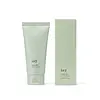What's inside
What's inside
 Key Ingredients
Key Ingredients

 Benefits
Benefits

 Concerns
Concerns

 Ingredients Side-by-side
Ingredients Side-by-side

Artemisia Princeps Leaf Water
MaskingWater
Skin ConditioningGlycerin
HumectantCocamidopropyl Betaine
Cleansing1,2-Hexanediol
Skin ConditioningDecyl Glucoside
CleansingPolyglyceryl-4 Caprate
EmulsifyingXanthan Gum
EmulsifyingSodium Chloride
MaskingMethyl Gluceth-20
HumectantLactobacillus Ferment
Skin ConditioningBifida Ferment Lysate
Skin ConditioningLactococcus Ferment
Skin ConditioningStreptococcus Thermophilus Ferment
HumectantCellulose Gum
Emulsion StabilisingCitrus Aurantium Bergamia Fruit Oil
MaskingCitric Acid
BufferingVinegar
Dipropylene Glycol
HumectantMalt Extract
Skin ProtectingButylene Glycol
HumectantPropanediol
SolventInonotus Obliquus Extract
Skin ConditioningInulin
Skin ConditioningSodium Phytate
Xylitol
HumectantFructooligosaccharides
HumectantArtemisia Annua Extract
MaskingAzadirachta Indica Leaf Extract
Skin ConditioningCamellia Sinensis Leaf Extract
AntimicrobialArtemisia Princeps Leaf Extract
Skin ConditioningHouttuynia Cordata Extract
Skin ConditioningRhamnose
HumectantCentella Asiatica Extract
CleansingGlyceryl Caprylate
EmollientLimonene
PerfumingLinalool
PerfumingArtemisia Princeps Leaf Water, Water, Glycerin, Cocamidopropyl Betaine, 1,2-Hexanediol, Decyl Glucoside, Polyglyceryl-4 Caprate, Xanthan Gum, Sodium Chloride, Methyl Gluceth-20, Lactobacillus Ferment, Bifida Ferment Lysate, Lactococcus Ferment, Streptococcus Thermophilus Ferment, Cellulose Gum, Citrus Aurantium Bergamia Fruit Oil, Citric Acid, Vinegar, Dipropylene Glycol, Malt Extract, Butylene Glycol, Propanediol, Inonotus Obliquus Extract, Inulin, Sodium Phytate, Xylitol, Fructooligosaccharides, Artemisia Annua Extract, Azadirachta Indica Leaf Extract, Camellia Sinensis Leaf Extract, Artemisia Princeps Leaf Extract, Houttuynia Cordata Extract, Rhamnose, Centella Asiatica Extract, Glyceryl Caprylate, Limonene, Linalool
Water
Skin ConditioningGlycerin
HumectantMyristic Acid
CleansingLauric Acid
CleansingPotassium Hydroxide
BufferingKaolin
AbrasiveStearic Acid
CleansingGlyceryl Stearate
EmollientLauryl Hydroxysultaine
CleansingGlycol Distearate
EmollientPalmitic Acid
EmollientLauryl Glucoside
CleansingPolyquaternium-22
Parfum
MaskingSalicylic Acid
MaskingSilica
AbrasiveOnsen-Sui
Zinc PCA
HumectantVolcanic Ash
AbrasiveDisodium EDTA
Propanediol
SolventLactic Acid/Glycolic Acid Copolymer
Skin Conditioning1,2-Hexanediol
Skin ConditioningMadecassoside
AntioxidantPolyquaternium-10
Ethylhexylglycerin
Skin ConditioningWater, Glycerin, Myristic Acid, Lauric Acid, Potassium Hydroxide, Kaolin, Stearic Acid, Glyceryl Stearate, Lauryl Hydroxysultaine, Glycol Distearate, Palmitic Acid, Lauryl Glucoside, Polyquaternium-22, Parfum, Salicylic Acid, Silica, Onsen-Sui, Zinc PCA, Volcanic Ash, Disodium EDTA, Propanediol, Lactic Acid/Glycolic Acid Copolymer, 1,2-Hexanediol, Madecassoside, Polyquaternium-10, Ethylhexylglycerin
 Reviews
Reviews

Ingredients Explained
These ingredients are found in both products.
Ingredients higher up in an ingredient list are typically present in a larger amount.
1,2-Hexanediol is a synthetic liquid and another multi-functional powerhouse.
It is a:
- Humectant, drawing moisture into the skin
- Emollient, helping to soften skin
- Solvent, dispersing and stabilizing formulas
- Preservative booster, enhancing the antimicrobial activity of other preservatives
Glycerin is already naturally found in your skin. It helps moisturize and protect your skin.
A study from 2016 found glycerin to be more effective as a humectant than AHAs and hyaluronic acid.
As a humectant, it helps the skin stay hydrated by pulling moisture to your skin. The low molecular weight of glycerin allows it to pull moisture into the deeper layers of your skin.
Hydrated skin improves your skin barrier; Your skin barrier helps protect against irritants and bacteria.
Glycerin has also been found to have antimicrobial and antiviral properties. Due to these properties, glycerin is often used in wound and burn treatments.
In cosmetics, glycerin is usually derived from plants such as soybean or palm. However, it can also be sourced from animals, such as tallow or animal fat.
This ingredient is organic, colorless, odorless, and non-toxic.
Glycerin is the name for this ingredient in American English. British English uses Glycerol/Glycerine.
Learn more about GlycerinPropanediol is an all-star ingredient. It softens, hydrates, and smooths the skin.
It’s often used to:
Propanediol is not likely to cause sensitivity and considered safe to use. It is derived from corn or petroleum with a clear color and no scent.
Learn more about PropanediolWater. It's the most common cosmetic ingredient of all. You'll usually see it at the top of ingredient lists, meaning that it makes up the largest part of the product.
So why is it so popular? Water most often acts as a solvent - this means that it helps dissolve other ingredients into the formulation.
You'll also recognize water as that liquid we all need to stay alive. If you see this, drink a glass of water. Stay hydrated!
Learn more about Water